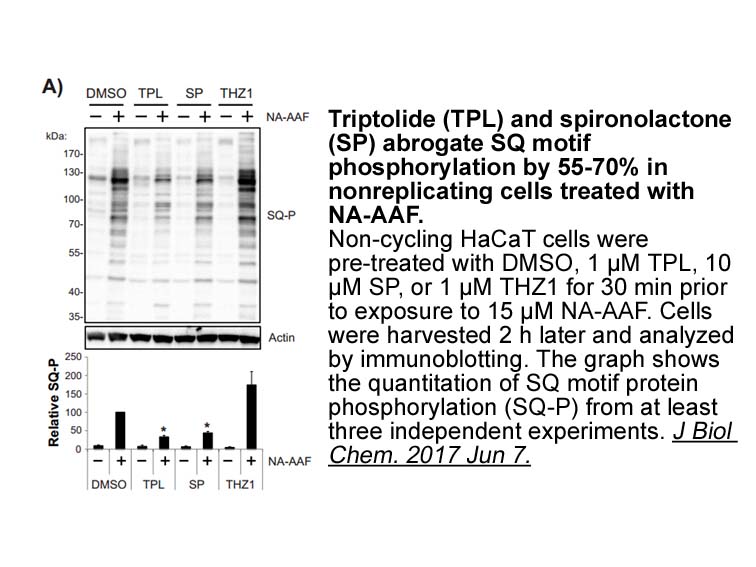Archives
Though limited to a large cohort of self
Though limited to a large cohort of self-reported healthy individuals, associations between individual a good thing have been identified which may be clinically significant. Though slight, there is a relationship between the CYP2D6-inferred metabolizer phenotype and the diplotype-predicted activities of UGT2B7, ABCB1, OPRM1, and COMT. This association highlights the need for comprehensive functional evaluation of the impact of polymorphisms in all five genes, and/or combinations of two, three, or four of these genes, on drug metabolism in the same individuals. It is reasonable to hypothesize that empirical evaluation of these targets will reveal the advantage of combinatorial pharmacogenetic profiles in regards to increased patient efficacy and even assisting with medico-legal accident reconstruction [18], [19], [20]. Currently, these data remain relatively scarce in the literature. The data presented herein provide a basis to interrogate the highly polymorphic T-metabolism pathway, defining full-gene haplotypes for, and characterizing the association between, five pharmacogenes that can be utilized in clinical pharmacogenetic evaluations and post-mortem molecular autopsy using gene-targeted MPS. It is likely that these data can be expanded upon, by interrogating additional ADME gene haplotypes, for broad applicability for predicting metabolizer phenotype following exposure to other opioid drugs.
Conflicts of interest
Acknowledgement
Introduction
Posttraumatic stress disorder (PTSD) is a trauma and stressor-related disorder that develops after experiencing or witnessing traumatic or terrifying event in some (i.e. vulnerable), but not all subjects [1]. The characteristic clusters of symptoms include re-experiencing the trauma (including intrusive memories, nightmares, flashbacks, emotional distress and physical reactivity after exposure to traumatic reminders), avoidance of trauma related stimuli, negative changes in thinking and mood, and trauma related arousal and reactivity. Psychological trauma might affect mood, emotions and cognition [2]. Therefore, impairments of the memory, attention, planning- and problem solving, i.e. in working memory and executive control functions, are the most frequent cognitive disturbances in PTSD [3,4].
Cognitive disruptions might be evaluated using the Rey–Osterrieth complex figure test (ROCF): copy, immediate recall and delayed recall [5], a nonlinguistic, neuropsychological test widely used to evaluate visuospatial, organizational, and visual memory skills. Administration consists of copying the figure first by copying it freehand (recognition), and then followed by two free-recall tasks, i.e., reproducing the figure from memory immediately and after a delay during which a different kind of task is administered. Examinees are not told that they will be asked to remember the figure; thus, the second two conditions are regarded as tests of incidental learning and visual working memory [6]. The ROCF is a valuable tool used to evaluate working memory and executive function mediated by the prefrontal lobe [5].
Dopamine affects cognition, especially in prefrontal cortex, due to its role in attention, vigilance, sleep and arousal. Increased dopaminergic prefrontal activity/availability is associated with improved working memory, attention and other executive functions [7]. Catechol-O-methyltransferase (COMT) degrades catecholamines including dopamine, and COMT affects prefrontal dopamine due to the scarce  location of dopamine transporter in this region. The enzymatic activity of COMT is altered by its functional polymorphism COMT Val158/108Met that influences dopaminergic activity [7]. COMT Val158/108Met, a guanine (G) to adenine (A) transition, results in Valine (Val) to Methionine (Met) substitution at codon 108 in soluble COMT (S-COMT) or codon 158 in membrane-bound COMT (MB-COMT) on chromosome 22 [8]. MB-COMT predominates in the brain [8]. The Met/Met homozygous genotype is associated with significantly reduced thermo-stability and lower COMT activity, slower dopamine degradation and increased prefrontal dopamine availability [[8],9]. Therefore COMT Val158/108Met variants (high activity in the Val/Val, intermediate activity in Val/Met, and low activity in Met/Met genotype, respectively) are associated with different dopaminergic phenotypes, cognitive abilities, executive functions and working memory [10,11].
location of dopamine transporter in this region. The enzymatic activity of COMT is altered by its functional polymorphism COMT Val158/108Met that influences dopaminergic activity [7]. COMT Val158/108Met, a guanine (G) to adenine (A) transition, results in Valine (Val) to Methionine (Met) substitution at codon 108 in soluble COMT (S-COMT) or codon 158 in membrane-bound COMT (MB-COMT) on chromosome 22 [8]. MB-COMT predominates in the brain [8]. The Met/Met homozygous genotype is associated with significantly reduced thermo-stability and lower COMT activity, slower dopamine degradation and increased prefrontal dopamine availability [[8],9]. Therefore COMT Val158/108Met variants (high activity in the Val/Val, intermediate activity in Val/Met, and low activity in Met/Met genotype, respectively) are associated with different dopaminergic phenotypes, cognitive abilities, executive functions and working memory [10,11].